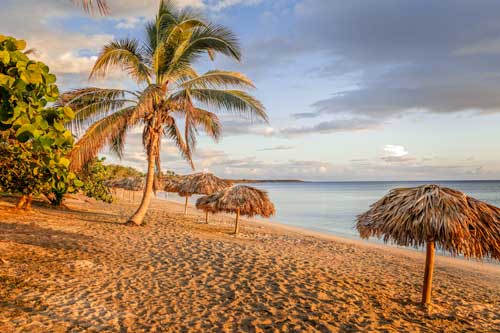Wildlife & Nature
10 Tropical Birds of Cuba
A Bee Hummingbird at Playa Larga
Photo: Shutterstock
Unveil the Wonder of Cuba’s Tropical Birds
As the sun begins to rise over the mountainous Sierra Maestra, revealing the expansive wetlands of Cienaga de Zapata, and illuminating Cuba’s precious waterfalls, the tropical birds of Cuba awaken the soul with melodic chirps that resonate through the morning air.
Cuba is by far the largest Island nation in the Caribbean, providing diverse regions with unique habitats for the natural development of over 270 species of Cuban birds - 21 of which are endemic.
Fly along with us and let’s drop by the nests of the most recognized bird species in Cuba, and where you can find these lovely feathered creatures.
Cuban trogon (Priotelus temnurus)
Photo: Shutterstock
1. Tocororo (Cuban trogon)
Draped in dark teals and bluish notes, in contrast to its white chest and bright red belly, the Cuban trogon strikingly reflects the patriotic colors of the Cuban flag, leaving no doubt as to why it is the national bird of Cuba.
Given the name ‘Tocororo’ because of the rhythmic pattern of its call, this cherished bird of the Trogonidae family can be seen throughout the Cuban archipelago - but for a close encounter - natural destinations like Sierra del Rosario, Topes de Collantes National Park, and Isla de la Juventud are most ideal.
In the mountains of Sierra Maestra, the Tocororo is still known as the Guariní - its native Taíno name.
Cuban Screech-owl (Margarobyas lawrencii)
Photo: Shutterstock
2. Siju Cotunto (Bare-legged Owl)
This wide-eyed little fella peering through the branches at night, blends perfectly in Cuba’s wooded areas with its pearly light brown and jasper colored feathers. They can typically be found nesting in large tree openings, stone fissures, and already dug-out holes from the neighboring woodpecker population.
The Bare-legged owl (also known as Cuban Screech Owl) tends to stick to lower grounds where they can access large insects, and in some cases, prey upon snakes or even smaller birds. They’re most likely to be found on islands and cayes such as Cayo Coco, and Isla de la Juventud.
Bee Hummingbird (Mellisuga helenae)
Photo: Shutterstock
3. Zunzuncito (Bee Hummingbirds)
At an unbelievable 6 centimeters in length, and weighing in at under 2 ounces, the Bee hummingbird is a marvel of nature as it flaps its tiny wings 80 times per second.
Their attractive metallic green backs and light cobalt blue tail feathers can be seen shimmering, but for a brief moment, while the Zunzuncito rests on a twig. The males sport an almost helmet-like style with the same steely qualities, but in a bright orange and dark fuchsia tone. Females possess a simpler grayish crown with a white neck.
The highest concentration of these little ones is in the province of Matanzas at Cienaga de Zapata National Park.
Cuban Grassquit (phonipara canora)
Photo: Shutterstock
4. Semillero Canoro (Cuban Grassquit)
A delight for any birdwatcher to see, the Cuban grassquit stands out from the foliage from the high southeastern provinces of Guantanamo and Santiago de Cuba.
The preferred habitat for the Semillero of the Tanager family, is mainly humid and subtropical. Its characteristic black face is surrounded by a bright lemony-yellow necklace that transitions into the bird’s mossy green posterior feathers.
Red-shouldered Blackbird (Agelaius assemilis)
Photo: Shutterstock
5. Sargento Cubano (Red-shouldered Blackbird)
Taking off like a black jet engine plane with yellow-tipped ember-red flames shooting out the sides, is the endemic Red-shouldered blackbird. A beautiful addition to birdlife in Cuba.
Given the name Sargento, meaning Sargeant, for its shoulders’ likeness to a military soldier’s epaulets (shoulder pieces), this striking species can be appreciated in the western provinces of Cuba and southern regions of North America.
Ivory-billed Woodpecker (Campephilus principalis)
Photo: Alamy
6. Carpintero Real (Ivory-billed Woodpecker)
Although it’s been declared extinct on at least 3 past occasions, the book on the Ivory-billed woodpecker is far from being closed, with investigative ornithologists finding more evidence of its existence in recent years. Its long expressive beak and flaring red crown plumage like a rock star, makes this Carpintero a favorite among woodpecker fanatics.
Also ranking as the second largest Piciformes species in the world, these legendary birds are said to have been sited in the village of Ojito de Agua, in the Farallones mountains of Alejandro de Humboldt National Park in Holguín.
Western Spindalis (Spindalis zena)
Photo: Shutterstock
7. Cigua Cubana (Western Spindalis)
The Spindalis Zena is a dashing specimen, highlighting the marriage between tropical hues and forestal patterns. With black and white stripes crossing horizontally to match its tail, the autumn-esque oranges and olives that make up its coat are a one-of-a-kind combination.
A native bird of Cuba, the Spindalis species has managed to do quite well for itself with large groups scattered around southern Florida, the Yucatan, and the Bahamas. They love staying low amidst bushes and fruit trees, and are even fortunately spotted in the city of Havana for those who can’t make the trip to the lesser-known parts of Cuba.
Blue-Headed Quail Dove (Starnoenas cyanocephala)
Photo: Shutterstock
8. Paloma Perdiz (Blue-Headed Quail Dove)
Like the dove that came from outer space, the Starnoenas cyanocephala is among the rarest of Cuban birds. It bears all of the normal features of an average quail dove, yet its indigo blue crown and dash of red on the beak with an almost zebra-like neck pattern, leaves quite an impression. Some ornithologists have even suggested that it should be considered a partridge-dove for its rarity.
They’re most frequently seen in the south western region of Cuba, especially at Playa Larga Beach in Matanzas, but, if you’re staying in Havana, you just might get a chance to see one up close.
Yellow-Headed Warbler (Teretistris fernandinae)
Photo: Shutterstock
9. Curruca de Cabeza Amarilla (Yellow-Headed Warbler)
Now this bird has one bright head on its shoulders. Despite having an almost even shade of gray throughout its body, this Cuban warbler has a particular yellow head in its entirety. The Yellow-Headed Warbler, also related to the Western Spindalis, is another bird from the west, sticking mostly to destinations like the province of Pinar del Rio.
Cuban Black Hawk (Buteogallus gundlachii)
Photo: Shutterstock
10. Busardo Cubano (Cuban Black Hawk)
An intimidating bird that definitely ruffles a lot of feathers with our previous mentions, the Cuban Black Hawk is endemic to Cuba with no other known subspecies, and is a top predator. Its dark disposition, with the exception of a yellowish beak and feet, adds to the powerful magnetism of this bird.
Cuban Black Hawks are always on the prowl, circling the coastal areas of Cuba from east to west, specifically thriving in the Jardines del Rey stretch of jaw-dropping cays that include Cayo Coco.
Cuban Macaw (Ara tricolor)
Photo: Wikimedia
11. Honorable Mention: The Extinct Cuban Macaw
This magnificent bird from the past may not be around anymore, but its disappearance serves as an example of the effects animal exploitation, deforestation, and overhunting can do to even the most beautiful of species.
The bright blue, red, and yellow colors of its feathers made them highly coveted during the 1500s - 1800s by colonizers and wealthy tradesmen, but by the time anyone could notice, the Macaws were already gone.
Written by Omar Guzman.
Published December 2022.
Explore Cuba's Wildlife & Nature
See Cuban Nature Up-close at Sierra Del Rosario
Reconnect with nature at Cuba's Sierra del Rosario nature reserve.
The Landscape of Cuba: Topes de Collantes
Enter and Explore Topes de Collantes. Home to amazing waterfalls
Scale the Peaks of Sierra Maestra
Enter the extensive Sierra Maestra mountains in Cuba, full of
Ciénaga de Zapata: A Natural Cuban Treasure
Encounter the endemic flora and fauna of Matanzas Cuba, and
Greatest Waterfalls in Cuba
Let the crystalline waters of the greatest waterfalls in Cuba
Best Spots for Fishing Around Cuba
Largely untouched and diverse, Cuba is one of the most
Explore Varahicacos Reserve in Varadero
Indulge in the landscape of Cuba at Varahicacos Ecological Reserve,
Explore the Glittering Caves of Bellamar
Dive into one of Cuba's most dazzling adventures in the
Find Hidden Oases in Havana’s Parks & Gardens We Love
Explore the lesser-known parks and gardens of Havana and dive
Categories
Tags
Share
Subscribe to our newsletter
Get more travel inspiration, tips and exclusive offers sent straight to your inbox

 Subscribe to our newsletter for the best monthly stories and insider guides about Cuba!
Subscribe to our newsletter for the best monthly stories and insider guides about Cuba!